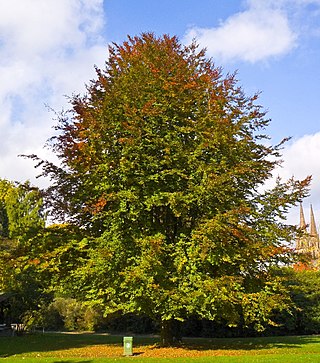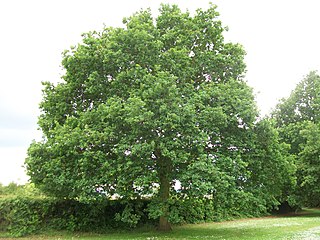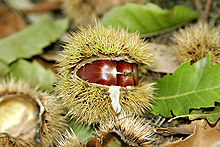
In botany, a fruit is the seed-bearing structure in flowering plants that is formed from the ovary after flowering.

The chestnuts are the deciduous trees and shrubs in the genus Castanea, in the beech family Fagaceae. The name also refers to the edible nuts they produce. They are native to temperate regions of the Northern Hemisphere.

The Fagaceae are a family of flowering plants that includes beeches, chestnuts and oaks, and comprises eight genera with about 927 species. Fagaceae in temperate regions are mostly deciduous, whereas in the tropics, many species occur as evergreen trees and shrubs. They are characterized by alternate simple leaves with pinnate venation, unisexual flowers in the form of catkins, and fruit in the form of cup-like (cupule) nuts. Their leaves are often lobed, and both petioles and stipules are generally present. Their fruits lack endosperm and lie in a scaly or spiny husk that may or may not enclose the entire nut, which may consist of one to seven seeds. In the oaks, genus Quercus, the fruit is a non-valved nut called an acorn. The husk of the acorn in most oaks only forms a cup in which the nut sits. Other members of the family have fully enclosed nuts. Fagaceae is one of the most ecologically important woody plant families in the Northern Hemisphere, as oaks form the backbone of temperate forest in North America, Europe, and Asia, and are one of the most significant sources of wildlife food.

A nut is a fruit consisting of a hard or tough nutshell protecting a kernel which is usually edible. In general usage and in a culinary sense, many dry seeds are called nuts. In a botanical context, "nut" implies that the shell does not open to release the seed (indehiscent).

In botany, a capsule is a type of simple, dry, though rarely fleshy dehiscent fruit produced by many species of angiosperms.

In seed plants, the ovule is the structure that gives rise to and contains the female reproductive cells. It consists of three parts: the integument, forming its outer layer, the nucellus, and the female gametophyte in its center. The female gametophyte — specifically termed a megagametophyte — is also called the embryo sac in angiosperms. The megagametophyte produces an egg cell for the purpose of fertilization. The ovule is a small structure present in the ovary. It is attached to the placenta by a stalk called a funicle. The funicle provides nourishment to the ovule. On the basis of the relative position of micropyle, body of the ovule, chalaza and funicle, there are six types of ovules.

Lithocarpus is a genus in the beech family, Fagaceae. Trees in this genus are commonly known as the stone oaks and differ from Quercus primarily because they produce insect-pollinated flowers on erect spikes and the female flowers have short styles with punctate stigmas. At current, around 340 species have been described, mostly restricted to Southeast Asia. Fossils show that Lithocarpus formerly had a wider distribution, being found in North America and Europe during the Eocene to Miocene epochs. The species extend from the foothills of the Hengduan Mountains, where they form dominant stands of trees, through Indochina and the Malayan Archipelago, crossing Wallace's Line and reaching Papua. In general, these trees are most dominant in the uplands and have many ecological similarities to the Dipterocarpaceae, the dominant lowland tree group. These trees are intolerant of seasonal droughts, not being found on the Lesser Sunda Islands, despite their ability to cross numerous water barriers to reach Papua.

Chrysolepis is a small genus of plants in the family Fagaceae, endemic to the western United States. Its two species have the common name chinquapin. The genus occurs from western Washington south to the Transverse Ranges in Southern California, and east into Nevada.

Castanopsis, commonly called chinquapin or chinkapin, is a genus of evergreen trees belonging to the beech family, Fagaceae. The genus contains about 140 species, which are today restricted to tropical and subtropical eastern Asia. A total of 58 species are native to China, with 30 endemic; the other species occur further south, through Indochina to Indonesia and the Philippines, mountainous areas of Taiwan, and also in Japan. The English name chinkapin is shared with other related plants, including the golden chinkapins of the Pacific United States, which are sometimes included within Castanopsis but are more often considered a separate but very closely related genus, Chrysolepis.

In the flowering plants, an ovary is a part of the female reproductive organ of the flower or gynoecium. Specifically, it is the part of the pistil which holds the ovule(s) and is located above or below or at the point of connection with the base of the petals and sepals. The pistil may be made up of one carpel or of several fused carpels, and therefore the ovary can contain part of one carpel or parts of several fused carpels. Above the ovary is the style and the stigma, which is where the pollen lands and germinates to grow down through the style to the ovary, and, for each individual pollen grain, to fertilize one individual ovule. Some wind pollinated flowers have much reduced and modified ovaries.

Castanea crenata, the Japanese chestnut or Korean chestnut, is a species of chestnut native to Japan and Korea. Castanea crenata exhibits resistance to Phytophthora cinnamomi, the fungal pathogen that causes ink disease in several Castanea species. The mechanism of resistance of Castanea crenata to Phytophthora cinnamomi may derive from its expression of the Cast_Gnk2-like gene.

Castanea pumila, commonly known as the Allegheny chinquapin, American chinquapin or dwarf chestnut, is a species of chestnut native to the southeastern United States. The native range is from Massachusetts and New York to Maryland and extreme southern New Jersey and southeast Pennsylvania south to central Florida, west to eastern Texas, and north to southern Missouri and Kentucky. The plant's habitat is dry sandy and rocky uplands and ridges mixed with oak and hickory to 1000 m elevation. It grows best on well-drained soils in full sun or partial shade.
This glossary of botanical terms is a list of definitions of terms and concepts relevant to botany and plants in general. Terms of plant morphology are included here as well as at the more specific Glossary of plant morphology and Glossary of leaf morphology. For other related terms, see Glossary of phytopathology, Glossary of lichen terms, and List of Latin and Greek words commonly used in systematic names.
Lithocarpus encleisacarpus is a tree in the beech family Fagaceae. The specific epithet is from the Greek meaning 'enclosed fruit', referring to the acorns and cupules. The cupule is not fused to the nut though and often becomes irregularly dehiscent. The degree to which the nut is enclosed by the cupule varies across its geographic range. Trees in Lithocarpus are commonly known as the stone oaks and differ from Quercus primarily because they produce insect-pollinated flowers.
Lithocarpus jacobsii is a tree in the beech family Fagaceae. It is named for the Dutch botanist Marius Jacobs. Trees in Lithocarpus are commonly known as the stone oaks and differ from Quercus primarily because they produce insect-pollinated flowers.
Lithocarpus kalkmanii is a tree in the beech family Fagaceae. This species is named for the Dutch botanist Cornelis Kalkman.
Lithocarpus revolutus is a tree in the beech family Fagaceae. The name is derived from the way in which the margins of the leaves are typically rolled in upon themselves (revolute). Trees in Lithocarpus are commonly known as the stone oaks and differ from Quercus primarily because they produce insect-pollinated flowers.

Castanea seguinii, called Seguin chestnut, Seguin's chestnut, or Chinese chinquapin, and in Chinese: 茅栗, mao li, is a species of chestnut native to south‑central and southeast China.

Quercus subgenus Quercus is one of the two subgenera into which the genus Quercus was divided in a 2017 classification. It contains about 190 species divided among five sections. It may be called the New World clade or the high-latitude clade; most species are native to the Americas, the others being found in Eurasia and northernmost North Africa.














